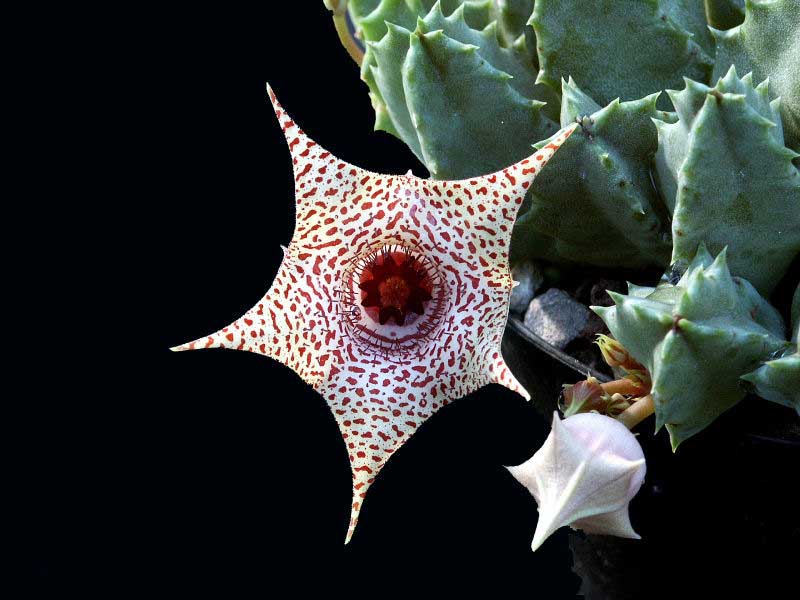The Huernia is an extraordinary plant that captures attention with its unique appearance and beautiful, albeit malodorous, flowers. Coming from the Asclepiadaceae family, Huernia originates from the sun-drenched regions of Eastern and Southern Africa. As a succulent, it boasts a remarkable adaptability and resilience, making it a favored choice among plant enthusiasts seeking a distinctive addition to their collection.
Characteristics and Growth
Huernia is a relatively small plant, typically reaching heights of 15 to 30 cm. Its growth rate is considered low, but it compensates with a long lifespan, continuously producing new shoots over time. The succulent’s thick, fleshy stems are designed to store water, a trait honed in its native arid habitats. Its survival-oriented design is complemented by distinctive star-shaped flowers that bloom prolifically at the base of its stems. Despite their visual appeal, these flowers are notorious for emitting an unpleasant odor, a fascinating adaptation to attract pollinators like flies.
Optimal Growing Conditions
For those interested in cultivating Huernia, replicating its natural environment is key. In terms of temperature, the plant thrives in a warm setting during the summer but requires a cooler atmosphere in winter, ideally not exceeding 50-53.6°F. Huernia prefers bright sunlight, which is crucial for its growth and flowering. However, care should be taken not to place it directly against glass windows to avoid leaf burn from intense sun exposure.
Soil and Watering Requirements
Huernia prospers in well-draining soil, which is vital to mimic the arid conditions it is accustomed to. A commercial succulent soil with an added touch of sand works well, or an expertly mixed blend of coarse sand or perlite, garden soil, humus, peat, charcoal, and bone meal. When it comes to watering, less is more. The soil must be allowed to dry out between waterings, especially in the warmer months where irrigation every 10-15 days suffices. During its dormancy in the cooler months, from November to February, watering should be heavily reduced.
Feeding and Fertilizing
The growing season sees Huernia benefiting from monthly feeds using a diluted cactus fertilizer. This gentle nourishment supports healthy stem and flower development, ensuring robust growth and a spectacular display of blooms.
Propagation Techniques
Huernia can be propagated through cuttings taken from May to July. The cuttings should be allowed to dry before rooting in peat, sand, or water. Additionally, propagation via seeds is a feasible method in April. Seeds typically germinate in a peat-sand mixture over a period of three to four weeks, making it a rewarding technique for patient gardeners.
Repotting and Maintenance
Each spring, it is advisable to repot Huernia every two years using shallow containers. This practice accommodates its root growth and refreshes the soil. Although generally resilient, Huernia is susceptible to root rot if overwatered, underscoring the importance of cautious watering. While it enjoys a reputation for being pest-resistant, maintaining the right conditions minimizes any such occurrences.
Unique Care Considerations
A notable aspect of Huernia care is its required winter dormancy. Providing a rest period away from the usual watering and feeding routines aligns with its natural cycle, promoting vigorous growth and blooming when the growing season resumes. Despite its rarity in facing pest issues, ensuring good air circulation around the plant is always beneficial.
Cultivating Huernia offers an enriching experience, combining ease of care with the reward of observing its unusual blooms. This succulent not only enhances indoor greenery with its fascinating structure but also connects plant enthusiasts with the diverse and adaptive world of African flora.






